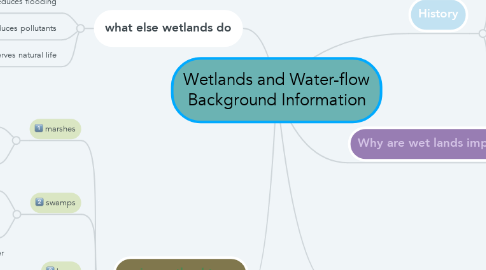Wetlands and Water-flow Background Information
by Matthew Bierman

1. major wetland types
1.1. marshes
1.1.1. duck, geese, herons, cranes, rails, marsh wren, yellow warbler
1.1.2. muskrats, beaver, otter, frogs, water snakes, turtles
1.2. swamps
1.2.1. dryer, woody plants,
1.2.2. frogs, grey tree frogs, salamanders, barred owls, waterthrushes, warblers, water shrews, raccoons, ducks
1.3. bogs
1.3.1. decaying plants, mold and moss over water, toxic water,
1.3.2. bugs, salamanders, fish
1.4. life style of 3 common water fowl.
1.4.1. wood ducks
1.4.1.1. many wood ducks come to eat acorns and aquatic seeds they live in trees not too far way from the wetlands
1.4.2. blue-winged teal
1.4.2.1. they like shallow wetlands and live about a mile away
1.4.3. mallard
1.4.3.1. nest are about 500ft away when there eggs hatch they lead them to the pond to eat the bugs and natural vegatation
2. what else wetlands do
2.1. reduces flooding
2.2. reduces pollutants
2.3. preserves natural life
3. History
3.1. glaciers started to melt and left behind lake Michigan and the rivers streams and ponds
3.2. soon the forest came back and brought animals like mastodons caribou and bear sized beavers
3.3. the Indians used the wetlands but when the Europeans came they thought of the wetlands as a problem for building
4. Why are wet lands important?
4.1. because wetlands are where water meets land it provides us our water resources. and many native plants and animals that live in the wetlands.
5. when managing waterfowl
5.1. restore any drained water from farms or other things.
5.2. make sure that grass and tress are planted 100ft around the pond area for ducks.
5.3. keep watch on any plants that may be dangerous from overgrowing to the animals around the wetland.
5.4. do not use any and chemicals be smart.
5.5. keep humans pets and predators away from the wetlands



